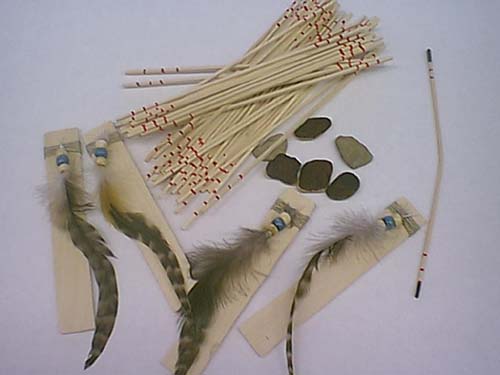| Origin: | Penobscot Nation in Maine U.S |
| History: | This dice game was often played in special gaming houses. Players would wager furs, knives, or axes. Entire villages would choose one individual to represent them in large games with other villages. |
| Original Materials: | Carved bone or antler - dice; twigs and sticks |
| Adapted Materials: | 6 stones - dice; 56 narrow sticks; 4 flat sticks, 1 crooked stick; wooden bowl or basket |
| Players: | 2 players |
| Setup: | Paint one side of the dice the same color (brown or white). To create a "crooked stick" boil or steam one stick until you can bend it without it breaking; shape the stick and secure it, then let is dry over night. |
| To Play: | The object of the game is to acquire as many sticks as possible then bankrupt your opponent. There are three phases to the game. First, players try to accumulate as many sticks as possible to create a primary pile. Second, players need to move their sticks into a treasure pile. And then the third phase of the game occurs when one player has enough markers in their second pile to bankrupt the opponent. |
| To Score: | | First Phase | - All of the small counters are placed in a central pile. For each successful roll of the dice a player is awarded a stick.
- When a player rolls 5 alike (painted or blank) then they are awarded 3 narrow sticks and get to roll again. If a second five alike is thrown the player receives 9 narrow sticks and rolls again. If the player throws three consecutive 5 alike rolls then they are awarded a flat stick.
- When a player rolls 6 alike (painted or blank) then one flat stick is awarded and the player rolls again. If a second 6 alike is rolled then the player is awarded two flat sticks. If a third consecutive 6 alike is rolled then the player is awarded three flat sticks.
- Players take turns casting dice until all counters are used. The last stick to be awarded is the "crooked stick". This piece has the value of one small counter and the winner is awarded two small sticks from the opponents pile.
| Roll | 1st roll | 2nd roll | 3rd roll | | 5 alike | 3 narrow sticks | 9 narrow sticks | 1 flat stick | | 6 alike | 1 flat stick | 2 flat sticks | 3 flat sticks |
| | Second Phase (Drifting) | - When the crooked stick has been won, the game enters a new phase. Players continue to roll the dice but now a 5 alike awards the player to move a stick from the first pile to a treasure pile.
- The goal is to get as many sticks as possible into your treasure pile. For each stick that is put in the treasure pile, your opponent owes you 4 sticks from their first pile.
- For two consecutive 5 alike throws the player puts three sticks into the treasure pile. For three consecutive 5 alike throws the player puts 1 flat stick into the treasure pile.
- For a 6 alike roll the player places a narrow stick into a third pile. This stick is called a "Chief" of "Governor" and is worth 4 of the opponents treasure sticks, one flat stick, or 16 narrow sticks from the first pile.
| Roll | 1st roll | 2nd roll | 3rd roll | | 5 alike | 1 narrow stick | 3 narrow sticks | 1 Chief stick | | 6 alike | 1 Chief stick | 2 Chief sticks | 3 Chief sticks |
| | Third Phase (Paying Up) | - When one player has a big treasure pile and believes they can bankrupt the opponent the game will enter the final phase.
- If you challenge your opponent, both then need to pay up all of the markers they owe for the Chief sticks.
- If your opponent pays up all of their markers and is bankrupt you win, but if they are in possession of the crooked stick they get three final throws. If they receive either a 5 or 6 alike they win the game.
| 1 Chief stick = 4 opponent's treasure pile narrow sticks | | Or | | 1 Chief stick = 1 flat stick or 16 narrow sticks from the 1st pile |
|
|
| Variations: | Hubbub (see game #4) is a simpler version of this game. |
| Math Content: | Probability, patterns and relations, numbers and operations, data management |
| Source: | http://www.nativetech.org/games/bowl&dice.html
|
|  |

